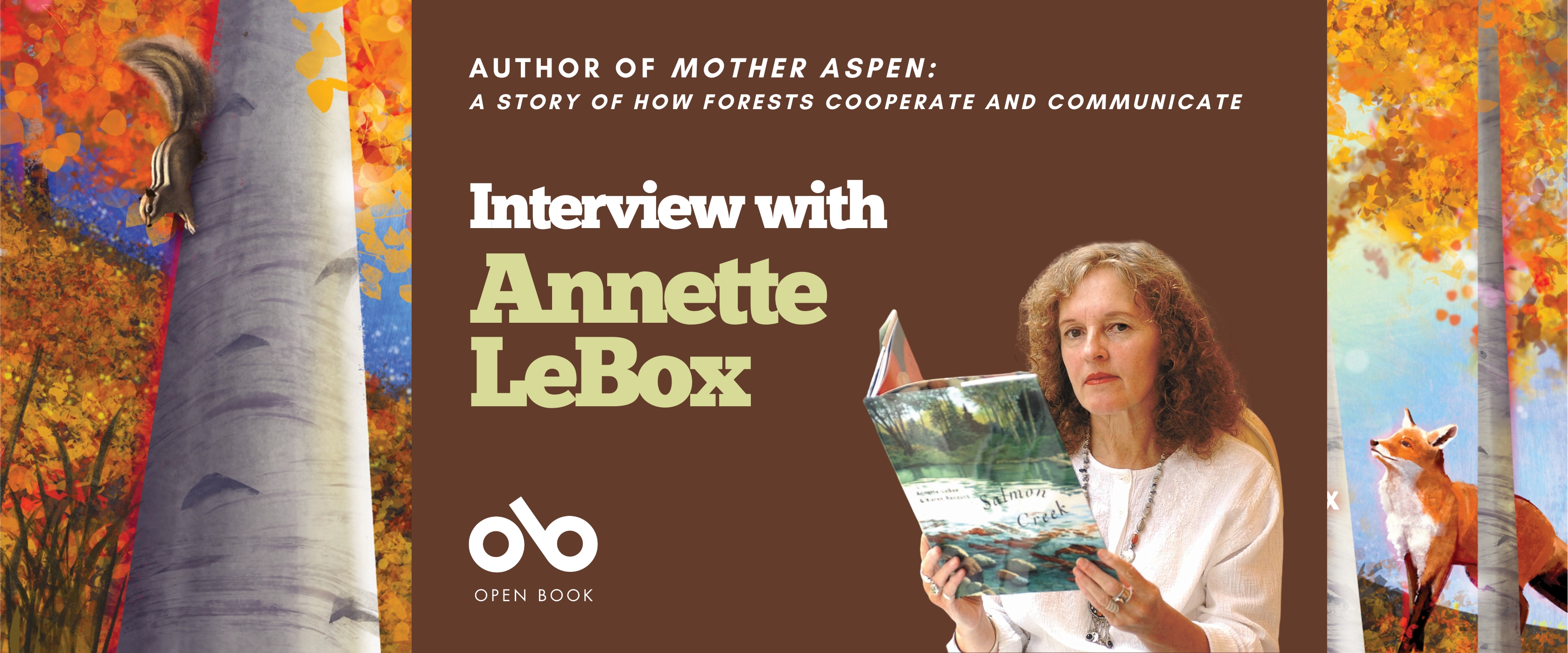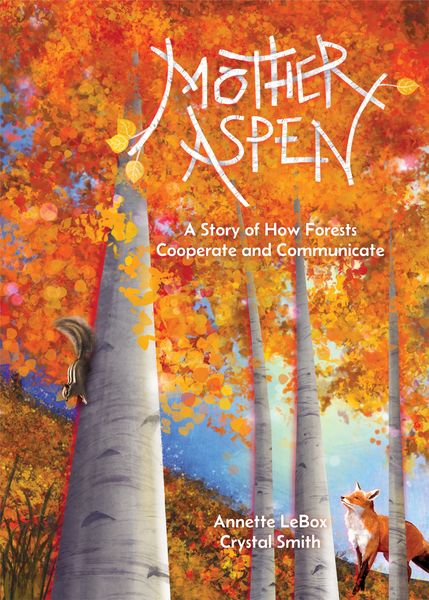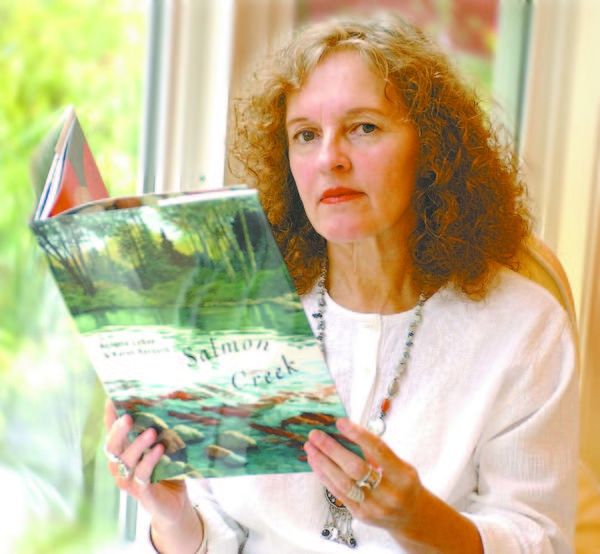One Mighty Mother Aspen Connects a Beautiful and Elaborate Ecosystem in a New Picture Book by Annette Lebox
As an author and environmentalist who spends much of her time in the remote Cariboo grasslands, two-time BC Book Prize winner Annette LeBox has keen insight into the power and beauty of our forests and wilds. Inspired specifically by an aspen grove behind a cabin at Meadow Lake, her new picture book is a celebration of the ways trees and woodlands behave and how they knit part of our world together.
In Mother Aspen: A Story of How Forests Cooperate and Communicate (Groundwood Books), LeBox tells a lyrical story about one particular mighty aspen tree in such a grove, and how this Mother Tree has functioned in this ecosystem for hundreds of years, sprouting children throughout the landscape that are all linked to her. This is just the beginning of an exploration of the symbiotic nature of the flora and fauna in the forest, and the myriad ways that all creatures and organisms interact in this particular wilderness.
The story follows the Mother Aspen through the seasons, with gorgeous illustrations by Crystal Smith, until the crucial moment when a violent storm wreaks havoc on this place and threatens the entire ecosystem, from the Mother Tree down to the fungus at her roots.
We're delighted to share this Kid's Club BFYP interview with the author today on Open Book!
Open Book:
Tell us about your book and how it came to be.
Annette LeBox:
The idea for a picture book about an aspen tree began many years ago when my husband and I bought a cabin at Meadow Lake in Central BC. Behind the cabin is a pine and aspen forest. In many ways, Mother Aspen: A Story of How Forests Cooperate and Communicate is a love poem to this aspen grove. In the fall, aspens turn a brilliant gold and the autumn light in the Cariboo creates a strikingly beautiful picture. Quaking aspen leaves are shaped so they make music in the wind, a ‘shush-shush-shushing’ sound which seemed magical to me. Yet it wasn’t until I read about Dr. Suzanne Simard’s The Mother Tree Project where I learned about the symbiotic relationship between trees and fungi, and how an Aspen grove looks like many separate trees but they are actually a single mother tree, that I saw the aspen forest with new eyes and I wanted children to be as full of wonder as I was.
I spent months doing research on forest ecosystems in general, and specifically about aspens in every season. As my knowledge grew, the structure of the story began to form. At that point I began writing the text, scanning each line as a poem. I enjoy playing with rhythm and rhyme, particularly slant rhymes—similar sounds which aren’t exactly perfect rhymes. It seems to me that slant rhyme is gentler and more subtle than end rhyme, though I include both kinds in my writing. The opening lines of Mother Aspen are an example of slant rhyme: ‘In early spring, the Mother Tree wakens. Her name is Quaking Aspen.’
My experience in witnessing wildlife at Meadow Lake informed the story. One day as I was digging out roots of water birch on the beach, a lovely young fox approached me a few feet away. I froze, mesmerized, while the fox rolled in the sand, glancing at me every few moments, so a family of foxes popped up in the text. Another time, as I was cross-country skiing in the bush, a moose and her calf crossed the trail in front of me, which was thrilling, so I included the two in my story. I also witnessed bats and bears and ruffed grouse going about their business. I wanted readers to know that an aspen forest harbours a rich variety of wildlife and that aspens are globally important for their resilience. Aspens trees are the first to grow back after floods, mudslides or fires.
When writing a picture book text, I’m aware of providing opportunities for an illustrator to create an image from each line I write. A picture book is a duet between the writer and the illustrator and I have been blessed by working with the talented artist, Crystal Smith, who has brought my words to life in the most dazzling way.
Your CanLit News
Subscribe to Open Book’s newsletter to get local book events, literary content, writing tips, and more in your inbox
OB:
What was the strongest or most memorable moment or experience during the writing process for you?
AL:
My most memorable experience was describing the moment when a violent storm downs the mother aspen. I had spent so many months thinking and writing about the aspen’s many gifts, that as soon as I wrote the words, ‘our mother is dead,’ I wept as if the tree were my own mother. I was upset, but not unhappy because I know that if I tear up at a point in my writing, chances are that the passage might strike an emotional chord with the reader. When the mother tree becomes a nurse log, she continues to give life to her young saplings and perhaps to a stray honeysuckle or fern, much the way human mothers provide a legacy to their children and grandchildren through memory.
OB:
What do you need in order to write in terms of space, food, rituals, writing instruments?
AL:
I need time to write without interruption. Every Friday morning, from 9 to 12, I meet two writer friends in the backroom of a coffee shop. We spend the first hour or so talking about our writing or socializing and then the remainder of the time we write quietly. I have a home office but I’m easily distracted by doing laundry, yard work, or house work. If I’m desperate to get some serious writing done, I go to the quiet room at my local library and chain myself to a chair for 5 hours with a bag lunch and a cappuccino.
OB:
How do you cope with setbacks or tough points during the writing process? Do you have any strategies that are your go-to responses to difficult points in the process?
AL:
My go-to strategy is to put that writing aside and work on something else. Once I leave a story that’s causing me grief, then return to it at a later date, I can sometimes find a solution or at least a way forward. I’m thinking of a dream-like piece of writing that I love but I can’t figure out a satisfying ending… yet. It’s been a year or so, but I think there’s something there. I just have to wait.
OB:
What are you working on now?
AL:
I’ve just begun writing a memoir called Chameleon: When life throws you an unexpected curve ball, you need to adapt to the situation on the playing field. My memoir is an account of childhood trauma, my time as a copycat bunny, meeting a handsome RCMP cop, divorce and my subsequent transformation from a good ‘girl’ to a woman who needed change and agency. It’s also a love story, when at fifty, I met my soul mate. As Mahatma Gandi said, “Adaptability is not imitation. It means power of resistance and assimilation.”
________________________________________
Annette LeBox is a poet and an environmental activist who divides her time between Maple Ridge, British Columbia, and a remote cabin in the Cariboo grasslands. She has won the BC Book Prize for illustrated children’s literature twice: for Salmon Creek, illustrated by Karen Reczuch, and for Peace Is an Offering, illustrated by Stephanie Graegin, which was also selected for Dolly Parton’s Imagination Library. She is also the author of the YA novel Circle of Cranes.
Crystal Smith is the daughter of a lighthouse keeper who discovered her passion for wildlife when she was small. She illustrates the natural world to spark curiosity and wonder, kindle concern and illuminate issues. She has also illustrated Mother Aspen, written by Annette LeBox. Crystal currently lives in Victoria, BC.






